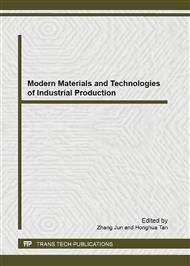p.3
p.9
p.14
p.19
p.23
p.28
p.32
p.39
Heat Treatments Effect on the Mechanical Properties of Industrial Drawn Copper Wires
Abstract:
In this present investigation, the mechanical properties of industrial drawn copper wires have been studied by creep tests, tensile tests and hardness Vickers. The effect of prior heat treatments at 500°C for different time on the drawn wires behavior was the main goal of this investigation. We have found that these heat treatments influenced the creep behavior of drawn wires and recorded shape curves. The creep tests were applied under ambient atmosphere at 240 °C. The creep duration before rupture decreased with the prior heat treatment time. The creep tests results were confirmed by tensile tests. A relationship between the hardness and the ultimate tensile strength of this industrial material has been established. Optical and scanning electron microscopy observations have been also used. Cross section observations of the wire after tensile or creep-rupture tests have shown that the mechanism of rupture was mainly controlled by the void formation.
Info:
Periodical:
Pages:
9-13
Citation:
Online since:
September 2013
Authors:
Keywords:
Price:
Сopyright:
© 2013 Trans Tech Publications Ltd. All Rights Reserved
Share:
Citation:


